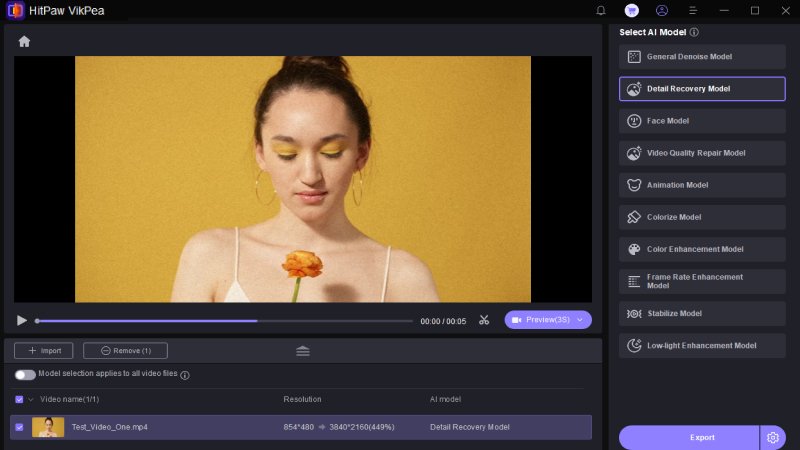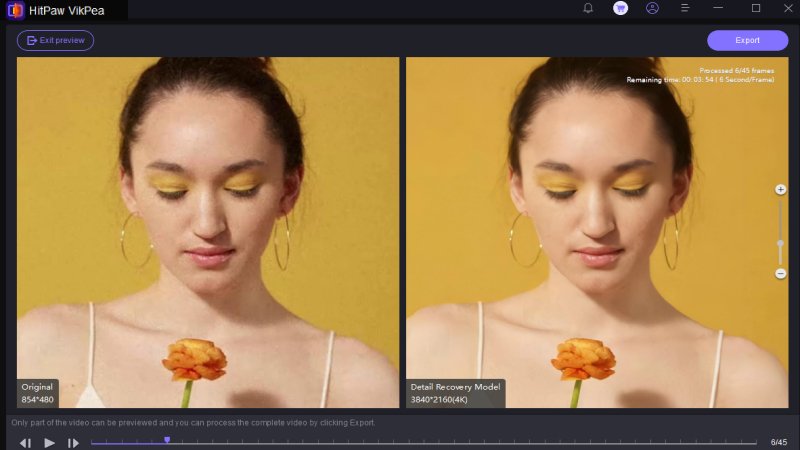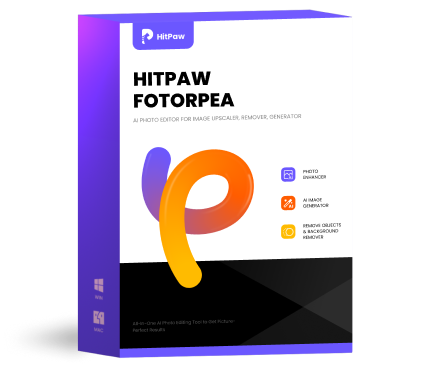Mastering the Art of Aspect Ratio in Cinematography
In filmmaking, every frame tells a story. The way in which that story is visualized can make all the difference. Aspect ratio in cinematography is the relationship between the width and height of a frame. And aspect ratio is not some technical detail, but rather it's a great storytelling tool. From grand, impressive widescreen frames to the close-up views of square frames, knowing how to utilize aspect ratio helps filmmakers create feelings, grab attention and tell memorable stories. This detailed blog post explores the important part of filmmaking and see how it can enhance your storytelling and engage your audience in a new way.
Part 1. What is Aspect Ratio in Cinematography?
Define aspect ratio in cinematography and its role in filmmaking
Aspect ratio is the relation between the width and height of an image or frame in film. It usually is represented in two numbers using a colon, such as 16:9 or 4:3. This simple ratio is very important in filmmaking because it influences how the audience views the story. Changing the aspect ratio can change the visual style, mood, and focus, and guide the attention of the viewer and increase their emotional connection.
For instance, a high aspect ratio may indicate grandeur or expansiveness; on the other hand, a low frame creates intimacy and focuses the audience's attention on characters or details. In this regard, filmmakers deliberately choose the aspect ratio depending on the theme and effect intended in the narrative.
Common aspect ratios (eg. 16:9, 4:3, 2.35:1) and their impact on storytelling
1. 16:9 (Widescreen)16:9 is the ratio for most modern TVs, streaming services, and digital movies. It's wide enough but not too tall, so it works well with action-packed thrillers as well as intimate dramas.
Effect: Useful for capturing sweeping vistas and character-focused scenes.
2. 4:3 (Academy Ratio)The old standard of early cinema and television, 4:3 offers a boxier frame. In recent years, it has gained popularity in contemporary films that require a retro or focused look.
Impact: Evokes nostalgia, closeness, and emotional attention.
3. 2.35:1 or 2.39:1 (Cinemascope/Anamorphic Widescreen)Commonly used for sweeping epics, this very wide ratio draws the audience into sweeping vistas and intricate action sequences.
Impact: Great for achieving a sense of scale, depth, and visual drama.
Examples of iconic films with effective use of aspect ratios
Here are some of the examples of iconic films with effective use of aspect ratios:
1. "The Grand Budapest Hotel" (2014) - Director Wes Anderson used multiple aspect ratios of 1.33:1, 1.85:1, and 2.35:1 to depict distinct stages of the tale, giving the narrative and images more complexity.
2. "Lawrence of Arabia" (1962) - Shot at 2.20:1, the expansive aspect ratio enhanced the impression of vastness in the desert, contributing to the film's epic grandeur.
3. "First Reformed" (2017) - Shot in 4:3, the film uses a square frame to emphasize the hero's estrangement and inner struggle.
Part 2. Contrast Ratio in Cinematography: Enhancing Depth and Emotions
Explanation of Contrast Ratio in Cinematography and its significance
Contrast ratio is the difference between the brightest whites and the darkest blacks in a picture. In cinematography, it is an important tool for setting the mood of a film. A high contrast ratio highlights clear differences between light and dark, making strong visuals, while a low contrast ratio provides softer, gentler images.
The importance of contrast ratio in cinematography lies in how it can stir emotions, show depth, and bring focus. Contrast ratios help the filmmakers make stronger visuals that have a connection with the story. It makes viewers understand the mood and meaning of the scene.
How contrast ratios influence mood, depth, and focus
Mood:- High contrast ratios, dark shadows, and bright highlights can create tension, mystery, or drama. They are often used in certain types of film, such as film noir or thrillers.
- Low contrast ratios make the images look flat and soft. This is actually good for light-hearted, nostalgic, or dreamlike visuals.
- A good contrast ratio can actually make flat screens look more three-dimensional, thus making images more real.
- It helps people better understand space because of the way it balances the light and shadows.
- Areas of high contrast automatically draw the eye to them.
- This makes it a strong tool to highlight parts of the image.
Tips for achieving the best Contrast Ratio in video editing
- Adjust Exposure Wisely: Film under proper lighting to retain details in both shadows and highlights.
- Use Color Grading Tools: Software such as Adobe Premiere Pro or DaVinci Resolve allows for fine-tuning contrast adjustments.
- Make Use of Vignettes: Subtly darken edges so that focus comes on the center subject.
- Inspect Monitors: Use high quality calibrated monitors in order to ensure that the correct contrast levels have been achieved.
Part 3. Lighting Ratio in Cinematography: Crafting Visual Drama
Define lighting ratio cinematography and its role in scene composition
Lighting ratio cinematography refers to the contrast of light intensity between the subject's key-lit side, bright, and fill-lit side, shadow. Stated as a ratio such as 2:1 or 8:1, it is one of the basic contrast control techniques that one has within a scene.
Lighting ratio has a significant impact on the feel and look of a scene. A high ratio, or high contrast, is used to build tension or drama, while a low ratio, or even lighting, is more natural and relaxing. Filmmakers use lighting ratios to create mood, guide the audience's attention, and focus on the emotional center of a scene.
Techniques for achieving balanced lighting ratios
- Use a strong main light to shine on the subject and a softer fill light to lessen shadows. Vary how bright the fill light is to get the right balance.
- Use a light meter to check how bright the main and fill lights are, to make sure the ratio is correct.
- Move the lights farther away or use diffusers to make the light softer and adjust brightness without making it too bright.
- Use three lights (key, fill, and backlight) to add depth and adjust the lighting ratio for more dimension.
- Use natural light with reflectors or bounce boards to get a good balance when filming outside.
Case studies: How lighting ratios are used to evoke emotions in films.
1. "The Godfather" (1972)The iconic low-key lighting with a high lighting ratio, for example, 8:1, underlined the dark, brooding world of crime, moral ambiguity, and power struggles.
2. "La La Land" (2016)Balanced lighting ratios during musical numbers, for example, 2:1, created a dreamy, romantic ambiance, which reflected the film's hopeful and whimsical tone.
3. "Blade Runner 2049" (2017)Extreme lighting ratios combined with bold colors conveyed the futuristic dystopia's emotional and psychological depth, enhancing the immersive experience.
Using HitPaw VikPea to adjust and perfect lighting in post-production.
HitPaw VikPea (formerly HitPaw Video Enhancer) is friendly yet very powerful video editing software that is designed to make the complicated tasks of post-production lighting adjustments simpler. Whether fine-tuning ratios for lighting, exposure correction, or creative lighting effects, HitPaw VikPea comes with some advanced features that bring out professional-grade results with relative ease.
Features
- Ensures clear details and brilliant colors by upscaling low-resolution videos to breathtaking 4K quality.
- Produces clearer, sharper images by automatically eliminating noise from videos.
- Improves frame rates to remove motion blur and stutters for more clear playback.
- Modifies saturation, contrast, and brightness to improve the visual attractiveness of your videos.
Steps to Enhance Video
Step 1. Download HitPaw VikPea from the official website. Follow the instructions and install the software.
Step 2. Launch HitPaw VikPea and upload your video file by dragging it into the interface or using the "Add File" option.

Step 3. Select the most appropriate AI enhancement model. Change the resolution (for example, upscale to 4K) and apply any other upgrades.

Step 4. Once the improvement is finished, export and save your high-quality videos to your desired location.

Learn More about HitPaw Video Enhancer
Bottom line
In cinematography, mastering the relationship of aspect ratio, lighting, and contrast is essential for making visually attractive and emotionally compelling films. These elements influence a film's plot and increase its artistic appeal. With tools like HitPaw VikPea, making professional-level changes is straightforward. Its simple capabilities for adjusting aspect ratios, lighting, and contrast make it a must-have for filmmakers looking to improve their visual storytelling. Try it now!






 HitPaw Edimakor
HitPaw Edimakor HitPaw FotorPea
HitPaw FotorPea HitPaw Univd (Video Converter)
HitPaw Univd (Video Converter) 
Share this article:
Select the product rating:
Daniel Walker
Editor-in-Chief
My passion lies in bridging the gap between cutting-edge technology and everyday creativity. With years of hands-on experience, I create content that not only informs but inspires our audience to embrace digital tools confidently.
View all ArticlesLeave a Comment
Create your review for HitPaw articles